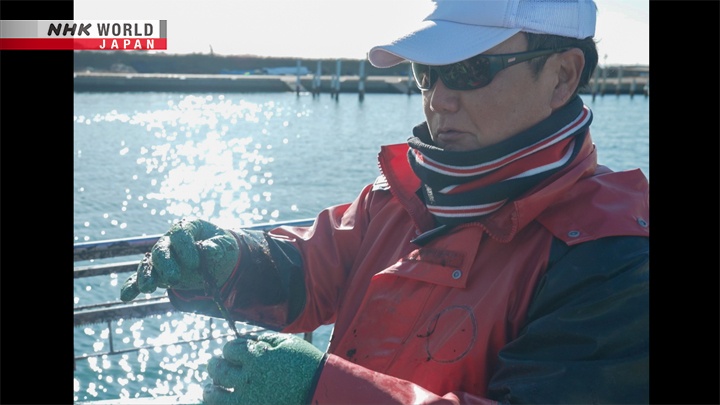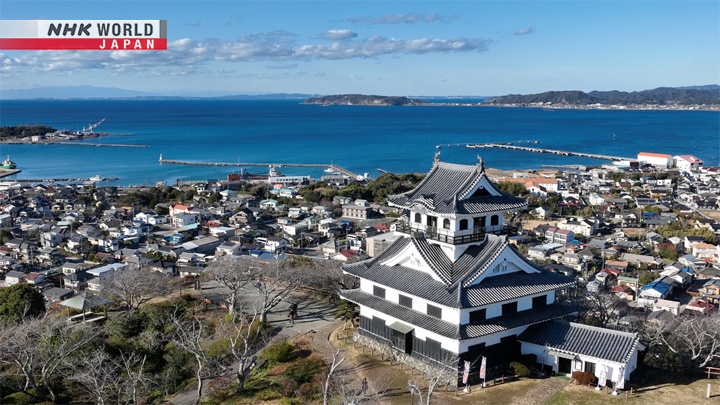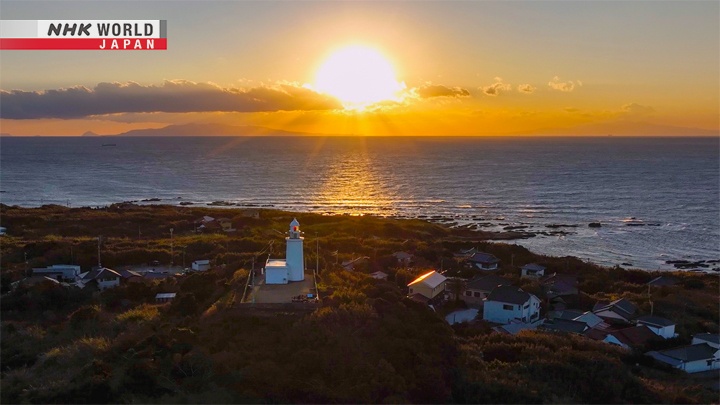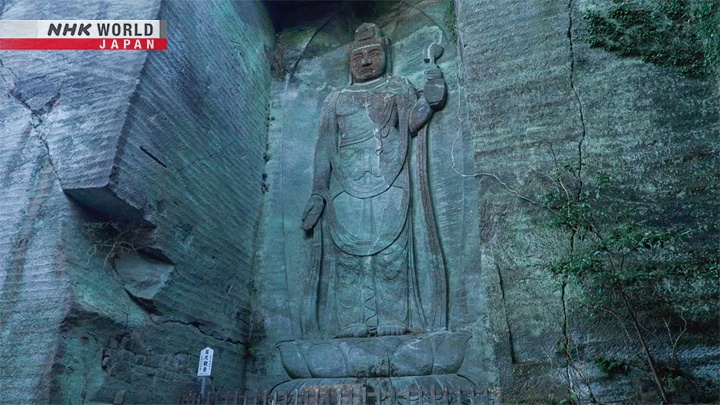Chiba's Peninsula: Along Tokyo Bay
Explore coastlines from a bird's-eye view! This time, the peninsula between Tokyo and the Pacific. We feature the Tokyo Bay side of the peninsula, which has long supported the city.




Transcript
On Coastal Encounters, we take to the skies for a bird's eye view of Japan's coastlines!
I'm your guide, Yumika!
This time, we visit the seas that support the metropolis of Tokyo.
It's a chance to look at Japan in a brand-new way!
I'm Dominic, and I'm coming along for the ride!
I'm looking forward to getting off the beaten path!
Our first stop is a popular leisure spot facing Tokyo Bay.
What is this place? I can see a little mountain...
This is the Tokyo Disney resort, in Urayasu.
Whoa, a theme park right on the water's edge.
Looks like it's connected to the ocean.
It's a 15-minute ride from Tokyo Station.
It's a huge draw, with over 20 million visitors a year!
This bird's eye view is great!
Today, we're traveling along Tokyo Bay, which faces the city of Tokyo.
We'll start at Urayasu, the home of that theme park,
and travel around the coast of Chiba prefecture.
We'll check out some little-known spots while making our way to the mouth of the bay in Sunosaki.
It's a 130-kilometer journey!
Can't wait to see what we'll find.
First, let's head east, deeper into the bay.
Tokyo is truly one of biggest cities in the world.
Look at those rows and rows of buildings.
Lots of rivers flow into the bay.
They dump a lot of sediment, so the coast is pretty shallow.
- Look, you can see the bottom.
- Right...
Land reclamation in Tokyo Bay began over 400 years ago, with tidal flats converted into land.
Now most of the coastline is reclaimed land.
That helped Tokyo become the giant city it is now, huh.
There's a place up ahead where the old sea still remains. See it?
Hmm... that waterside spot off in the distance there?
Exactly!
That far back? Looks like everything in front of it is reclaimed land?
Let's take a closer look.
This is Yatsuhigata, a tidal flat.
Because it's connected to the bay, and thanks to the ebb and flow of the tides, this natural environment remains.
So this is what the shore used to be like.
Lemme land and check it out.
Sure. Have fun!
This woman is looking through some binoculars.
Hi there!
Good morning!
What're you looking at?
I'm observing what kind of birds
are here at Yatsuhigata today.
What kinds have you spotted?
Right now, it's winter migratory birds.
A lot of types of ducks.
Hear those whistling chirps? Those are wigeons.
Those dark ones are called coots.
At Yatsuhigata, there are a lot
of sandpipers and plovers.
They migrate from places like Australia and Siberia.
They're said to travel about 10,000 kilometers.
This is an important natural habitat for them.
This place is surrounded by reclaimed land.
Why was it preserved as-is?
We get asked that a lot.
Reclamation started here in 1971.
At that time, us residents started activities like
nature watching meetings and trash collection.
Thanks to our efforts, this became a
protected tideland.
I see! Thanks to the efforts of local residents.
An important oasis for birds in the big city.
I hope it can stay this way for a long time.
The cityscape stretches on.
I see some kind of circular structure over there.
That's a baseball stadium.
It's home to about 70 pro baseball games a year.
As you know, Japan loves baseball!
I heard the wind from the ocean sometimes plays a role in how games turn out.
Hah, that sounds like an extra layer of excitement.
From here on out stretches three kilometers of man-made beach.
Now that's a fun use of reclaimed land.
I see a bunch of kids.
Some kind of pre-school class, I guess.
In summer, you can go swimming here.
Great way to escape the big city for a bit.
Wow, this looks like some kind of industrial complex.
This is Chiba's port.
It's one of Japan's largest international trading ports!
Connecting Japan to the world, huh.
This port has factories that process imported crude oil, plants that make steel from iron ore, and even power plants.
Japanese exports also go out from here.
Sounds like it really supports the lives of the people in this metropolitan area.
When the sun goes down, this area takes on a whole different look.
Whoa, how cool.
The factories looked pretty normal in the day,
but now they've taken on a whole sci-fi vibe.
It's like a movie set or something!
There's actually a popular night cruise where you can check out this view on the water.
Sounds kind of romantic, in a way.
Would make for a pretty unique date.
Let's move south alongside the bay.
What's that?!
Jeez, look at the length of that bridge!
That's an expressway called the Tokyo Bay Aqua Line.
I bet that's a great drive.
Huh? Looks like it just stops in the middle of the water.
Look closer!
- Oh, the cars are going under.
- That's right.
There's an underwater tunnel that connects to the other side.
It's like this so that ships can pass through.
That's some impressive Japanese engineering.
There are some shallows near the base of the expressway that dry up when the tide is low.
I see some kind of rectangular shapes.
Those are spots where they farm a kind of food we eat a lot of in Japan.
An underwater farm? What could it be.
Hey, a boat.
Seems like they're hard at work. Let's take a closer look.
The boat's kind of pulling at that net.
Looks like there's some kind of black stuff stuck to it, and they're pulling it off.
What is it?
There's a hint at this port.
It's called Kaneda Port, and it's famous for the product we're talking about.
Why don't you go take a look?
Sounds good!
Looks like a boat just returned to port.
Lemme get a look at what they farmed.
This must be that black stuff on those nets.
Hi there.
- Hello.
- What's that?
- This is nori.
- Nori?
You know, the black seaweed used to
wrap rice balls and sushi.
Thin, kind of like paper?
Right. This is raw nori.
So you farm it in the sea, huh?
Yeah. That's where it grows.
- These are nori leaves. They're chopped up,
turned into squares and dried to make that "paper."
- I see!
Actually, Chiba's nori isn't well known in Japan.
But locally, it's known for its great flavor.
Because it's a tidal flat, the water disappears
one or two kilometers from here at low tides.
The water is then replaced, and the nori
absorbs it, which makes it delicious.
I'd love to eat some. Where can I try it?
- I know a good place for lunch. Want to join me?
- Around here?
- Yes, it's close. I've got to clean the boat,
so wait a minute.
- Awesome. Thank you!
A restaurant recommended by a nori farmer. This is gonna be great!
So here it is.
Wonder how they use nori in their dishes.
Here you are. Enjoy.
Here're the nori dishes he ordered.
This one is sweet and salty clams wrapped in nori and rice.
We call this style "teppo-maki."
It's a kind of fast food for fishers.
You can eat with one hand
while steering the boat.
Quite big.
Just grab it and bite in, huh?
The flavor of the nori and clams is really good.
You can enjoy nori in ramen, too, it seems.
Nori comes in squares, of course, but this is another form.
This nori was just picked and dried as-is,
so it's more flavorful.
Adding it to ramen enhances the aroma.
Give it a whiff before you dig in.
I see.
Add it to ramen, and it really brings out the nori's ocean flavor.
This is the best.
Teppo-maki rolls with nori paper and nori ramen.
The bounties of Tokyo Bay on a plate!
Time to dig in!
Thanks for showing me around!
Keep up the great work!
Let's continue our trip.
I see a big cape poking out into the sea.
That's Cape Futtsu.
It really juts out far into the sea, doesn't it?
See those two small islands beyond?
Yeah, I think so.
They're both manmade!
Interesting. Why make islands out here?
They used to be sea forts!
They were conceived in the late 19th century as watchtowers and gun emplacements,
to protect Tokyo from Western powers, which were expanding into Asia.
They were used until the end of the Second World War.
Wow, the remnants of conflict.
You can still see some traces of those times.
These days, they're used to maintain the safety of ships coming in and out of the bay.
They're like the caretakers of Tokyo Bay.
Recently, tours have started up that show you the history of the islands.
You can even visit them.
Nice. I'd like to go sometime.
Next, up on our trip is this mountain.
It's called Nokogiriyama.
In Japanese, "nokogiri" means handsaw.
See those ridges? They look like the teeth of a saw.
Whoa, totally.
It's now a popular sightseeing spot thanks to its distinctive atmosphere.
Oh, near the summit, the surface is bare.
It looks like a cliff!
Lemme go take a closer look!
I landed on a path near the summit.
Check out these high rock walls.
It's like some kind of ancient remains.
I found an opening behind the rock wall.
Whoa, a huge Buddha carving.
It's gotta be 30 meters tall!
What's it doing here, anyway?
- Hello.
- Huh?
Oh, hello there.
- Hi.
- Who are you?
I'm Suzuki Hiroshi.
I'm a guide here.
Oh, great.
What kind of place is this?
This is a temple called Nihon-ji.
As you can tell, this used to be a stone quarry.
Aha, a former stone quarry turned into a temple.
No wonder it has such a mysterious atmosphere.
I've never seen a place like this before.
- Oh? There's an even more impressive
quarry around here. Let me show you.
- Wow, thanks!
Some of these steps are rough,
so please be careful.
We're going down.
Wonder where this leads to.
You can see Mt. Fuji clearly.
Great view, right?
Wow, indeed. I can see why you brought me here.
Actually, I want to show you
this precipice on the left.
It's like a castle in the sky.
Stone was cut from it. It's the quarry with
the greatest difference in height here.
It's about 100 meters tall.
- All cut by hand.
- Wow, by hand?
That's right.
It's a kind of stone called Boshu-ishi.
It was used in the 19th and 20th centuries
to build things in the Tokyo Bay area like ports,
railroads, and defensive bases in huge amounts.
At the peak, they cut 560,000 pieces per year.
This stone served as Tokyo's foundation.
Yeah, you could say that.
The stones were transported from Kanaya Port
to Tokyo and Yokohama by ship.
These stones, cut in such large amounts that it changed the shape of the mountain,
were shipped across Tokyo Bay and helped modernize the city.
Without this place, Tokyo might not have become what it is today.
Suzuki told me that his father was actually a stone cutter here.
But when concrete became the standard, about 40 years ago, the quarry closed down.
These days, it's a sightseeing destination.
The surface used to reach up to there.
They just kept cutting from the top.
That was the early 1960s.
I've always wanted to come here.
It's really nice.
Glad I came.
Some people say it feels spiritual,
with the quarry and the Buddhist temple.
The stone cutting made it quite beautiful.
My father thought of it as receiving
a gift from the mountain.
They had that kind of mentality.
That's what makes it beautiful and touching.
It's as if respect for the mountain is etched into the landscape.
We're almost at our final stop!
This is the city of Tateyama.
Its proximity to the mouth of the bay helped it flourish.
Whoa, there's a castle on top of that hill!
Can we go check it out?
Of course!
It's a reconstruction of the home of a powerful family that ruled here over 500 years ago.
These days, it's a park, and anyone can come see it.
Lemme land and take a look.
Look at this cute family.
Hi there.
What're you looking at?
The park where we always go.
Does it look good?
Yes.
The weather's nice, so we walked up here.
Not much wind, either.
Is the sea always this calm?
Hm, it was quite choppy a few days ago,
but now it's calm.
It's calm enough to be named Kagamigaura.
That means "mirror sea," right?
Right. I guess because there aren't many waves,
so it looks like a nice mirror.
That's what the sign by the mall says, anyway.
The calm, reflective sea does look a bit like a mirror.
Actually, it's been calm our entire trip, now that you mention it!
This is our final stop, Sunosaki.
It's the boundary between the bay and the open sea.
So beyond this point is the Pacific Ocean.
Ooh, a lighthouse.
It was built over 100 years ago, and has helped guide ships in and out of the bay ever since.
It's like it's overseen a century of changes here in Tokyo Bay!
Tokyo Bay just keeps evolving, responding to the needs of the city.
Travelling down it was a blast!
Tours with a perspective you can't get anywhere else.
Which coastline should we explore next?